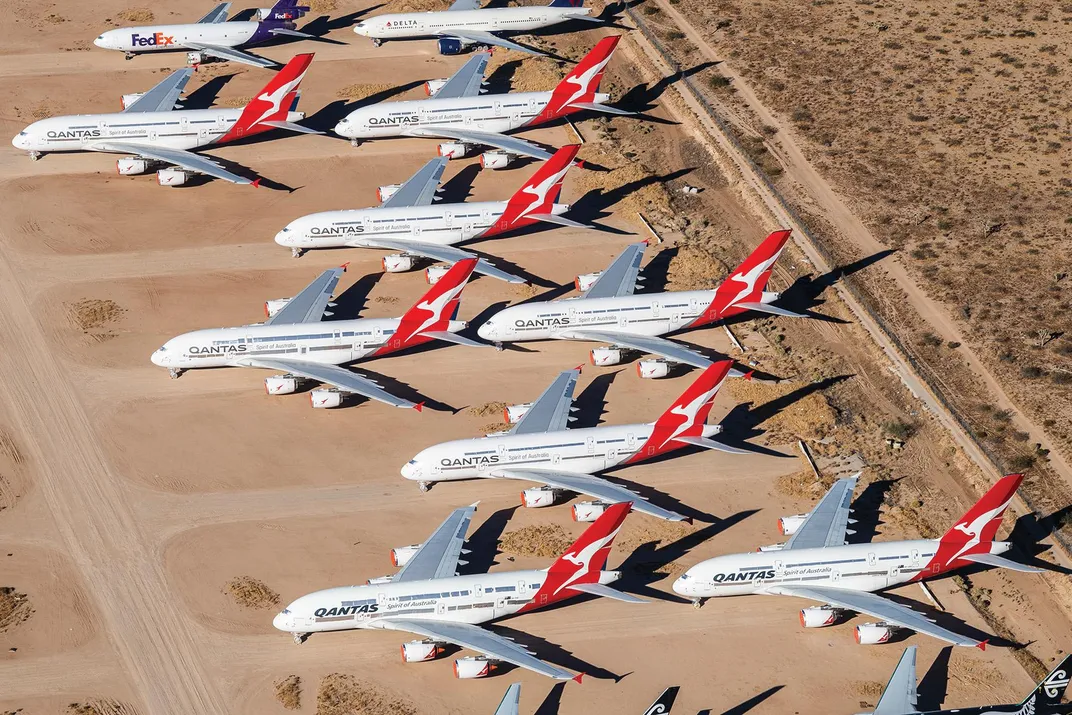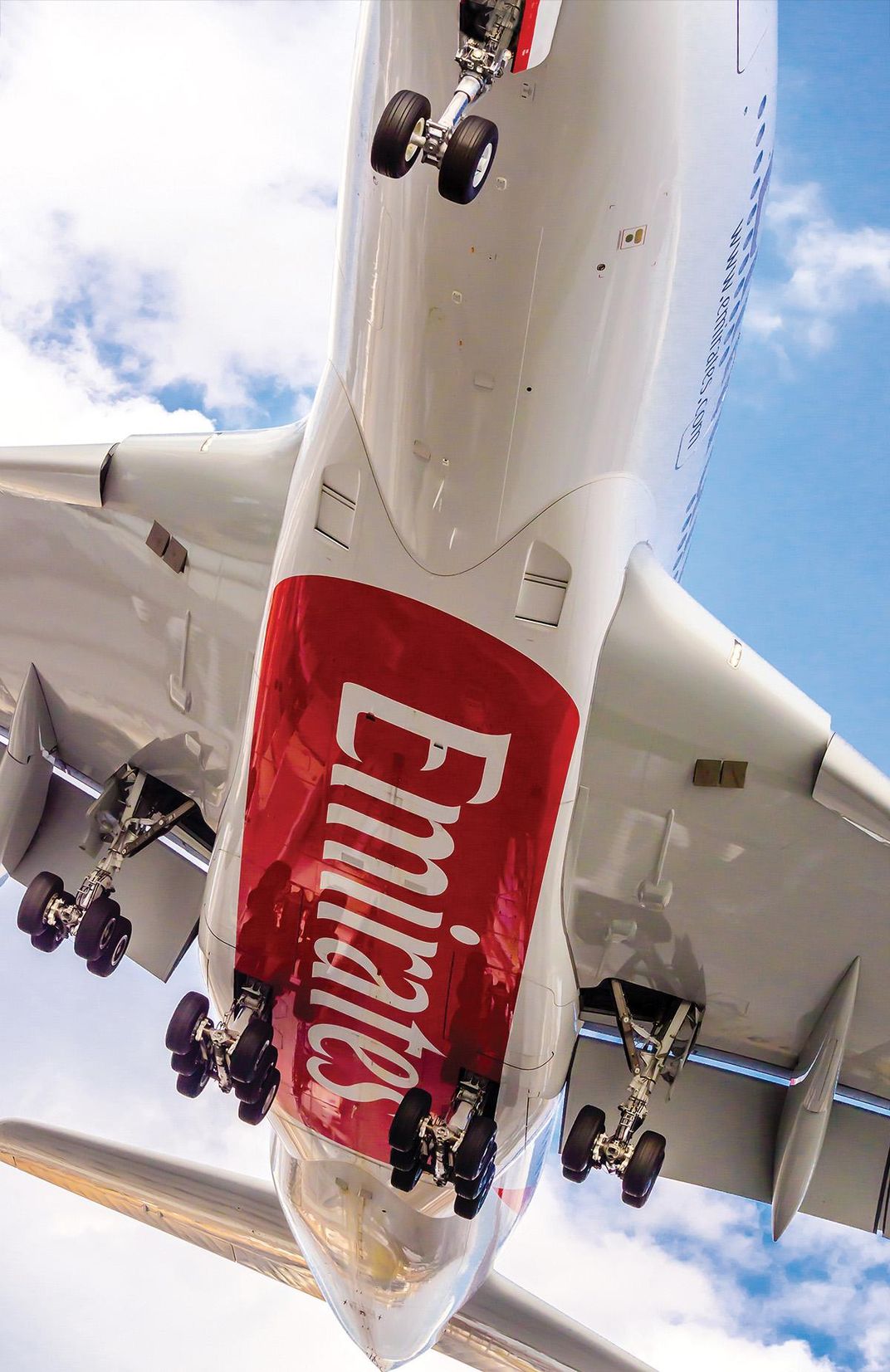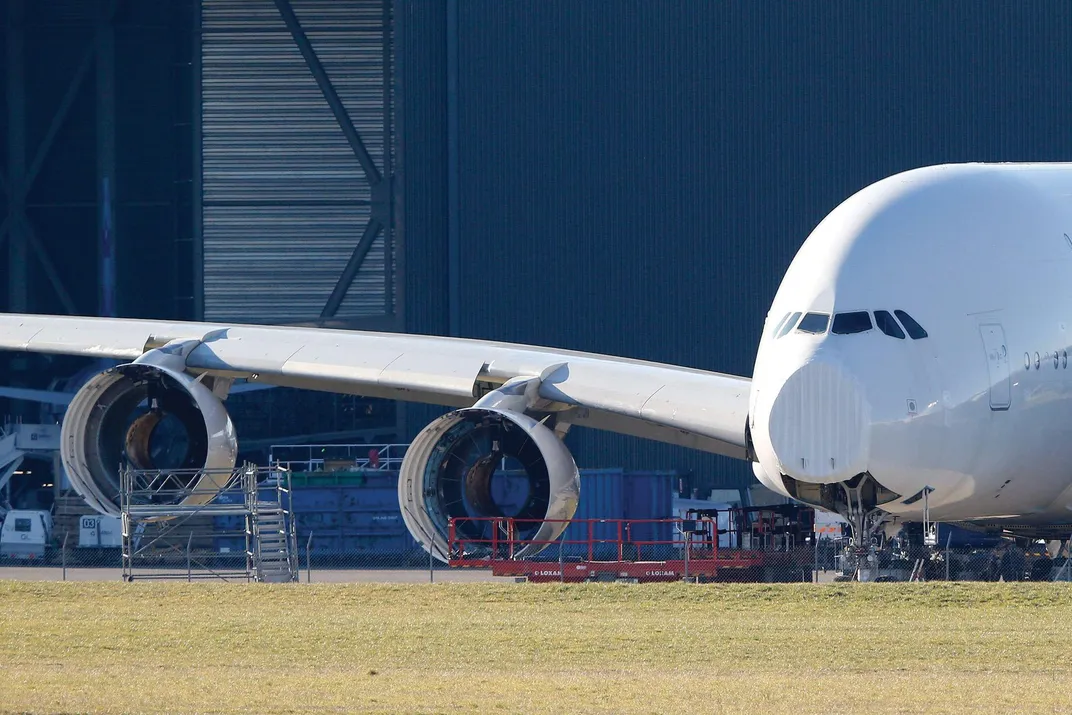Farewell to a Giant
Airbus struggled to invent the world’s biggest airliner. In the end, it wasn’t technology—it was timing—that killed the beast.
:focal(2355x1092:2356x1093)/https://tf-cmsv2-smithsonianmag-media.s3.amazonaws.com/filer/78/84/78844e95-10a5-4cd4-b41d-f5eb864d349b/06o_dj2022_lastsuperjumbos-fwwdd_010913_maks_live.jpg)
In a hangar in Tarbes, France, a team of hard-hatted maintenance technicians looked up at the aircraft towering 73 feet above them, the giant that once held the promise of dominating international air transport—the Airbus A380. The team wasn’t there for the airplane’s regular maintenance check. They had come to take it apart. Employees of Tarmac Aerosave, one of the world’s largest aircraft-recycling companies, they would work for the next six months to disassemble for recycling the world’s largest airliner, a four-engine double-decker that was 238.6 feet long with a 262-foot wingspan and an empty weight of more than 600,000 pounds.
This A380 had flown for only 10 years, a third of its intended lifespan. It started its career in 2007 with A380 launch customer Singapore Airlines, which began shedding A380s in 2017. Last year, the airline retired five more. When air travel became one of the victims of the 2020 pandemic, A380 retirements began to cascade. (COVID accelerated the retirements of other, older types as well.) Air France retired the last nine of its 10 giants; Lufthansa retired 14. Qatar Airways, once one of the A380’s biggest boosters, followed with five. Etihad announced last April that it was grounding its 10 A380s indefinitely in favor of smaller, twin-engine 787s and A350-1000s. The move was part of the airline’s pivot from an aggressive, luxury-focused expansion to increased efficiency required by pandemic economics.
But the big airliner’s troubles started long before the spread of the latest coronavirus. Some say they were baked in at the beginning. In February 2019, after its mainstay customer Emirates airline knocked down an order from 53 to 14, Airbus announced that it would end production of the historic airliner at the end of this year.
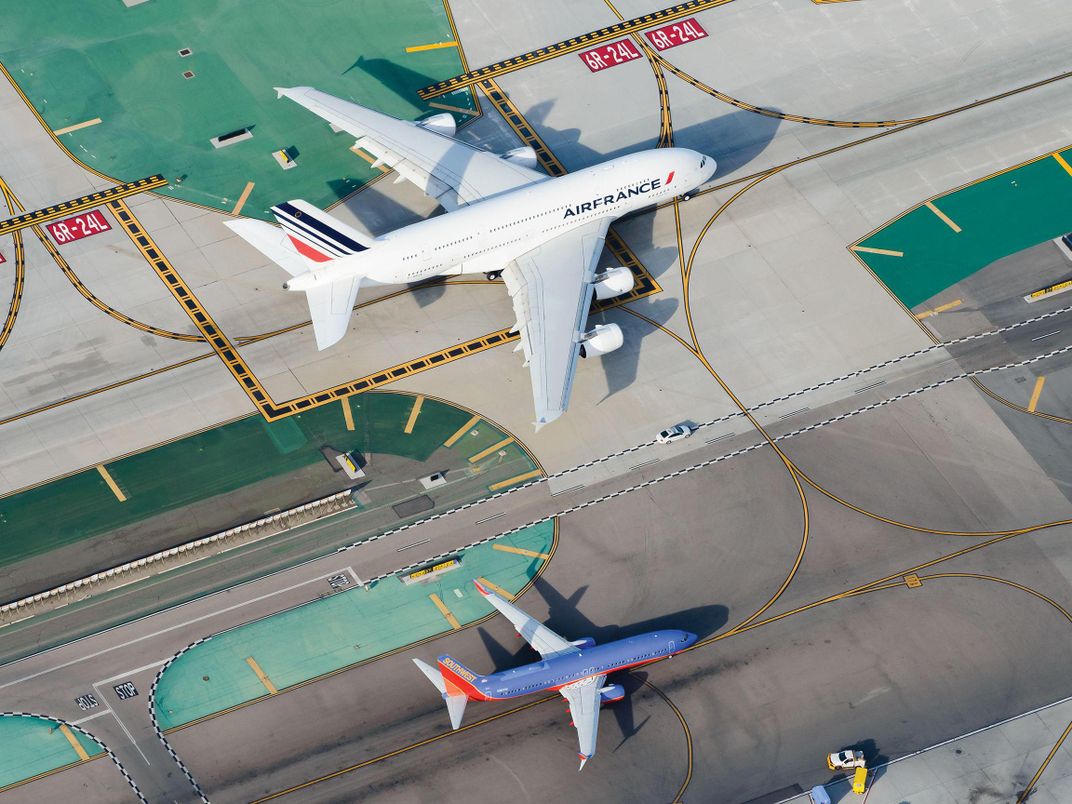
Birth of a King
On April 27, 2005, nearly 30,000 people gathered at the Airbus facility in Toulouse, France, to witness the A380’s first flight. Most were there to marvel that such a monster could actually fly. The product of a four-nation partnership, the superjumbo was the pride of Europe and a celebrity around the world. Three months before the flight, then-President Jacques Chirac of France, Prime Minister Tony Blair of Britain, and Chancellor Gerhard Schröder of Germany attended its public introduction. Chirac called it “a great European success.” He addressed an audience of 5,000 public officials, airline executives, suppliers, and journalists, saying, “When it takes to the skies, it will carry the colors of our continent, and our technological ambitions, to even greater heights.”
In October 2008, when the A380 landed in Los Angeles for the first time, the Qantas flight was met by John Travolta and Olivia Newton-John. When Lufthansa began flights between Frankfurt and Miami in 2011, the Miami SunSentinel crowed, “The A380 is so huge it has 220 windows and 55,450 square feet of floor space, more than the average Publix [grocery store].”
It was designed to carry up to 853 passengers in a single class, although most airlines chose the traditional three-class configuration that accommodated 550 passengers. With that arrangement, first-class travelers were treated to unprecedented comfort. “We wanted to open people’s eyes on how passengers can use the aircraft,” says Airbus senior sales director Frank Vermeire. “Many airlines included some social feature such as a lounge bar. Korean Air had a duty-free shop. On long flights, people want to get up and stretch their legs and we provided them with a place to go. Passenger reviews showed this was a differentiator. These features gave the A380 a buzz and set it apart from the rest of the market.”
What led first-class passengers to book flights specifically on the A380 (the Airbus website iflyA380 lists all the jumbo’s destinations and the A380-equipped airlines flying to them) are the suites. First offered aboard Singapore Airlines, first-class suites were advertised with double beds, lounge chairs, work spaces, and private bathrooms including showers.
“It certainly turned heads,” says Henry Harteveldt, founder of the Atmosphere Research Group, which analyzes marketing, customer service, operations, and e-commerce in the travel industry. “The engineering was extremely impressive as was the technology that it applied to other programs.”
You have not missed the chance to experience the A380. It still flies for five airlines. Qantas and British Airways, with 12 each, have plans to return the aircraft to service. During a recent conference, British Airways CEO Sean Doyle indicated there were multiple suitable destinations for the superjumbo. In addition to high-volume routes to Hong Kong or Johannesburg, he pointed to Boston, Miami, and Washington. Singapore plans to resume flights with its remaining 18. Emirates CEO Tim Clark said the aircraft would fly for the airline into the 2030s. Emirates intends to retain 117 of the aircraft, by far the largest fleet. “But the airplane was by no means the economic success Airbus had hoped it would be,” Harteveldt admits.
Michael Goldstein put it well recently in Forbes: “The A380 was one [airplane] every passenger wanted to fly, but ultimately, no airline wanted to buy.”
Harteveldt muses, “If Airbus had built it in the 1980s or early 1990s, perhaps it would have been a more popular airplane. It was really the victim of the industry’s own progress, given the development of twin-engine aircraft like the Boeing 777 and the Airbus A330.”

The Safest Way to Travel
By the late 1980s, major hub airports around the world—London’s Heathrow, New York’s John F. Kennedy, Tokyo’s Narita, Chep Lap Kok in Hong Kong—had nearly reached capacity while the number of passengers continued to grow dramatically. As a solution to the limited number of takeoffs and landings these airports could accommodate, most aircraft manufacturers and the airlines they served believed that giant airliners could ease congestion by increasing the number of passengers carried for every departure and arrival. Indeed, according to a recent World Military & Civil Aircraft Briefing by the Teal Group, in the 1980s top aircraft lessor Tony Ryan was calling for a 1,000-seat 747 by 1990 for domestic flights and a 2,000-seat “super 747” for international services.
But a counter-trend also began in the 1980s that would eventually ease the pressure on the major hubs. In the middle of that decade, the Federal Aviation Administration certified the two-engine Boeing 767 to fly what the air travel industry calls “extended-range operations,” which opened several transoceanic routes that had once been the exclusive domain of three- and four-engine airliners. Because of extraordinary advances in the reliability of aircraft turbofan engines, such as the General Electric GE90 and the Rolls-Royce Trent, the FAA and its international counterparts became confident that should an airliner lose an engine, its remaining engine could get it to an airport a specified number of hours away. By 2011, when the calculation became up to five and a half hours away, the twin-engine Boeing 777 and Airbus A330 could fly anywhere.
Today, twin-engine airliners routinely fly routes that were once reserved for the jumbos, and those routes take them from one so-called “feeder” airport to another—“point-to-point” flights—bypassing the congested hubs, shortening travel time for passengers, saving money for the airlines, and—increasingly importantly to regulators and the flying public—reducing carbon emissions. Moreover, those smaller airliners are easier to fill with paying customers than the enormous A380. When the giant flew with only 70 percent of its seats occupied, it cost almost the same to operate as a full flight did.
Foreseeing the shift in the air travel industry, Boeing lost faith in the market for a superjumbo and in 1995 withdrew from discussions it had been having with Airbus about a partnership to produce a mega-airliner. Boeing eventually turned to the much smaller but enormously successful 787. Airbus continued alone.
Frank Vermeire defends the decision. “Every 15 years traffic doubles,” he says. “The problem is the biggest growth is at the major global hubs—London, Los Angeles, Paris, Hong Kong, Singapore—which were already getting more and more congested. They were also unable to expand, so the only way to grow was to have larger aircraft delivering more people with each flight. The question was how to use the existing infrastructure more efficiently, and the only way to do that was with larger aircraft.”
Vermeire believes that, no matter how many hub-bypass routes there are, the mega-hubs still need the A380.
Emirates airline proves his point. For Emirates, all routes lead to Dubai, which in 2013, after decades of extravagant promotions to lure tourists, became the world’s busiest international travel hub. Someone in the Dubai government recognized that the city was located within eight hours of two-thirds of the world’s population. Dubai’s royal family created the airline in 1985 and funded airport expansions, making the city both destination and nexus with an airport that is one of Dubai’s many tourist spectacles (its Terminal 3 is one of the largest buildings in the world).
Perhaps no one exploited the A380 more than the Middle East 3: the two flag carriers of the United Arab Emirates—Emirates and Etihad—and Qatar Airways. Emirates cited the superjumbo as a key part of its strategy. The -380 was instrumental in building their hubs at not only Dubai, which was specifically designed around the airplane, but also at Abu Dhabi and Doha.
In May 2020, Emirates CEO Tim Clark told the Financial Times that the A380 has a “place in the Emirates international network on the scale it has before. Albeit not today or fully next year, but the year after I think there will be a place for it, and I think it is going to be extremely popular.”
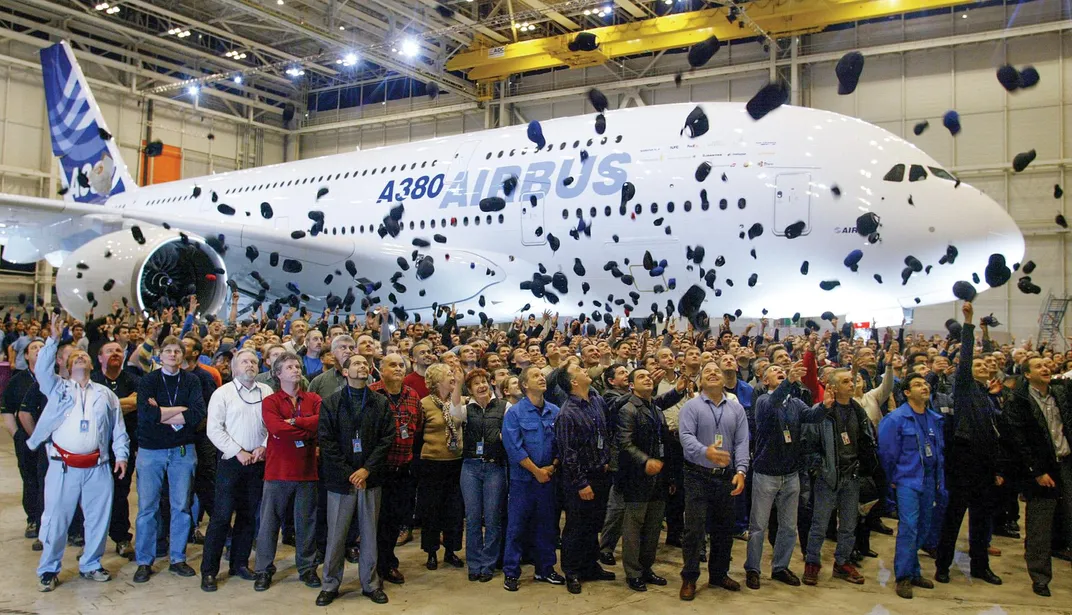
Flying High
When Airbus launched the A380 program in 2000, its strategists believed that its new giant airliner would not only satisfy the airlines’ need to meet growing passenger demand but would also deliver operating costs 15 percent lower than those of the 747. The company was mounting a direct challenge to Boeing’s iconic widebody. Further, Airbus expected its superjumbo to trigger an increase in demand similar to that prompted by the 747 in the 1970s, when capacity increases prompted dramatically lower intercontinental fares.
The airlines shared that optimism. Even after the gut punch dealt the air travel industry by the 9/11 attacks, airlines were buying. By mid-2003, more than two years before the first A380 was expected to be delivered, Airbus had 129 orders. The European conglomerate that had delivered its first airliner (the A300) a mere 29 years before was now nipping at Boeing’s heels. Its suite of airplanes sold well; its deliveries in 2000 were almost equal to those of the colossus in Seattle. Three years later, Airbus surpassed Boeing.
Vermeire admits that with the A380 the company was reaching for something as transformative as the 747 had been. “We didn’t just want to launch a big aircraft,” he says. “We wanted to deliver a step change. There were a lot of breakthroughs. Social media posts boasted how quiet it was. A lot of carriers used the 380 as a springboard to introduce a more glamorous product into the market.” Even the A380’s structural material was innovative: Airbus introduced a glass-fiber-reinforced aluminum composite that reduced the airplane’s weight. The reduced weight in turn saved fuel and increased range. But it wasn’t just about the hardware. Like its invention of fly-by-wire flight controls with the A320, the A380 symbolized for Airbus a culture of innovation and engineering excellence. When Singapore Airlines took delivery of the first superjumbo, the London-based news magazine The Economist observed, “With the A380, Airbus has now risked everything; not only to kill off its rival’s greatest cash cow, but also to create a similarly enduring icon to capture the imagination of the world’s travellers.”

On the Other Hand
“The A380 resulted from hubris, shoddy market analysis, nationalism, and simple wishful thinking,” says Richard Aboulafia, vice president of analysis at Teal Group. “Very simply, route fragmentation and airline right-sizing are clear realities. Even the Asia market is being transformed. The 777/787 and A330/350XWB are doing great, and together all the smaller, twin-aisle jets have racked up well over 4,000 orders since the A380 was launched. In fact, it’s the only new aircraft ever launched with major carriers denying that they needed it.”
When the A380 entered the market, Japan Airlines, along with several U.S. lines, stated they had no interest. None of them placed orders.
Atmosphere Research Group’s Henry Harteveldt is kinder. “Watching that hulking A380 take off makes people stop and say, ‘Wow, how’d they do that?’ But only half of passengers pay attention to the type of aircraft they fly. Instead, they look at the amenities, the Wi-Fi, the legroom.
“From a passenger standpoint, I don’t think the A380 captured passenger hearts the way the 747 did. There is a passionate community of aviation geeks who go out of their way to fly the A380, and undoubtedly Emirates was able to leverage the A380 to distinguish itself from competitors. People lament the passing of the jumbo jets, but passengers are not going to stop flying because there are no more 747s. The pandemic didn’t cause that. The advances in technology and aircraft did that.”
The A380 did achieve lower operating costs than the 747-400, but such advantages disappeared with the advent in 2012 of Boeing’s 747-800, the largest variant of the world’s first wide-body. In 2014, just seven years after the first delivery of the A380, operators began to express the first inklings of disenchantment. By that year, orders had slowed so much that Airbus acknowledged the unlikelihood that it would recoup the $19 billion to $25 billion A380 investment—five times the original estimate—despite a $445.6 million list price. (Aboulafia reports that discounts put actual prices between $215 million and $230 million.)
Qatar Airways CEO Akbar Al Baker, who took delivery of his final A380 in 2018, called it the biggest mistake the airline had ever made. Known for signaling his displeasure with manufacturers through the press, Baker said the A380 caused more damage than benefit to both the airline and the environment. A 2020 report by the International Council on Clean Transportation indicated that 787s and A350s were more carbon efficient than the A380. The group also analyzed airports and found that Dubai was the most CO2 intensive of the world’s 10 busiest.
Airbus cancelled the A380 after only 12 years of production. (The 747 is also ending production next year, after 52 years.) Instead of an eventual market for 1,200 giant aircraft that the company foresaw in the 1990s, only 251 orders materialized, with 248 already delivered. The final A380 delivery is set for May 2022.
“There is no secondary market at all,” says Aboulafia. “Just a lot of dead, stupid metal.”
Only one used aircraft found a second home—a retired Malaysian A380 was leased by Hi Fly for two and a half years. It is now destined for Tarmac Aerosave.
How Many Techs Does It Take to…
Jumbo aircraft might not have resale or lease value, but as a neatly chronicled assemblage of parts, they’re worth as much as $50 million, according to an analysis by the aviation media company FlightGlobal. The Tarmac Aerosave team confronting the A380 in Tarbes eventually harvested 5,000 parts from each of the first two jumbos retired by Singapore Airlines. According to Grégory Beyneix, vice president of the company’s operations group, the paperwork alone for the parts on each airliner—verifying certification and maintenance records—took a month to complete.
“Once that is done, we first have to remove any risk from all the liquids such as fuel and hydraulics,” he says. Beyneix says there are 12 techs who work on cleaning the aircraft “in what we call a greening process to ensure contaminants are not introduced into parts headed for recycling.” These “greeners” are joined by a two-person team from the environmental department for the final segregation and preparation to ship the material to the recycling channels.
All major systems must be depressurized; then, with harvest list in hand, workers scramble up airstairs and electric lifts to get to work. After compiling the paper histories, workers clean, inspect, and repair each part before it is put in inventory with its documentation, including 20 pictures establishing a paper trail of its care and feeding over its lifetime. Without such records, the part’s value drops to zero.
Some of the first items removed include auxiliary power units, emergency slides, avionics, and electronics. Then comes the cabin side and ceiling panels and interiors. Workers also separate categories of materials, such as metals, cables/hoses, and hazardous materials so the scrap can be shipped to proper facilities for further recycling.
The company has several teams comprising 35 or 40 technicians who work in shifts on each aircraft. Four break apart the avionics bay and flight deck, five remove the four giant Rolls-Royce Trent powerplants. The engines alone are worth several million dollars. Others dismantle flight surfaces, ailerons, flaps, rudders, wings, flight controls, hydraulics, and fuel systems. Another dozen strip the vast 6,000-square-foot interior, including frame structures, evacuation equipment, cabin interiors, seats, galleys, lavatories, and inflight entertainment equipment. Some of the last items for removal are the landing gears. Once they’re gone, cranes shift the giant to enormous purpose-built jigs, which took months to fabricate.
Only 10 percent of the aircraft—plastics, foams, and fabrics—cannot be recycled, although such airlines as Southwest recycle leather seat covers for consumer products. Once all is complete, it takes only six workers two to three weeks using diamond cutters to break the aircraft frame into smaller parts for recycling. On YouTube, a sad video chronicles the dismantling process: An A380, once so full of energy and promise, is transformed into a lifeless hulk (airspacemag.com/scrap). It’s hard to watch.
Despite program cancellation after only 20 years, the Airbus A380 delivered an entirely new travel age, one that continues to serve the world’s mega hubs and, for some passengers, make air travel exciting again. “There’s something else the -380 has done for industry and will do for many years to come,” concludes Vermeire. “It is an icon of aviation and was groundbreaking when it entered service. Passengers realized it was something different.”
While the A380 may have been controversial, there is no question it was consequential.
Veteran aviation and travel journalist Kathryn B. Creedy is the author of Time Flies—The History of SkyWest Airlines. She was able to cross “ride on the A380” off her must-do list in 2018 with a flight from L.A. to Guangzhou, China.
